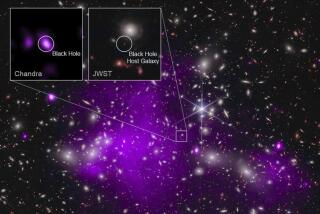Greater Light Shed on Elusive Black Holes : Science: Hubble Space Telescope’s images indicate invisible force in nearby galaxy is swallowing stars.
- Share via
Astronomers using the Hubble Space Telescope say they have made a significant advance toward confirming the existence of black holes--massively heavy, super-condensed galactic centers that are so strong even light cannot travel fast enough to escape their pull. The Hubble findings, announced in Washington on Wednesday, also show that black holes may be more common than was formerly believed.
A black hole, by its very nature, cannot be seen. But the Hubble images show that stars in a nearby galaxy, M32, become extremely concentrated toward the center. Some strong--and invisible--force is apparently exerting enough gravity to suck the stars toward the black hole.
The astronomers have calculated that the apparent black hole weighs about 3 million times more than the sun, though it occupies about the same space.
The new Hubble results are “certainly the strongest evidence yet of a very massive black hole,” said Ed Weiler, program scientist for the orbiting telescope.
“We’ve got the feathers and the feet to show it’s a duck, but we haven’t got the quack,” Weiler said. The main reason for the lack of a quack is the Hubble’s flawed mirror, which was ground to the wrong specifications and consequently sends blurry images back to Earth.
If a repair attempt planned for next year is successful, “we’ll get the quack,” Weiler said.
Clearer images could enable scientists to determine the speed of the clustered stars. If the stars get progressively faster toward the center of M32, it will be considered definitive confirmation of the extreme gravitational pull, which could also be accurately calculated, Weiler said.
If the force were not a black hole, said Sandra Faber, an astronomer at UC Santa Cruz who helped analyze the images, the only other alternative “would be collapsing stars that are evolving into a black hole.”
The images provide “another brick in the wall,” supplementing earlier Hubble data from another galaxy, shuttle instruments and recent ground-based observations, Faber said.
M32 is “a very boring, uninteresting galaxy” of typical size and shape, Weiler said. Finding this gravitational force in such an average galaxy says “black holes may be a lot more ubiquitous than we thought.”
Black holes were predicted by Albert Einstein’s general theory of relativity, but as recently as last year, they were often referred to as theoretical.
To make a black hole out of the sun, its mass would have to be packed into a sphere with a radius of about two-thirds of a mile. To make a black hole out of Earth, its mass would have to be compressed into the size of a marble.
For decades, no such objects were detected and some scientists were beginning to voice doubts that they exist.
Then in 1990, astronomers said radio telescopes in the New Mexico desert had picked up evidence at the center of our own galaxy, the Milky Way, of the kind of violent activity that would take place in the immediate neighborhood of a black hole.
The same year, instruments aboard the shuttle Columbia, measuring X-rays and ultraviolet light, found similar evidence in the heart of the galaxy Markarian 335.
Earlier this year, astronomers reported that Hubble images showed a concentration of stars at the center of the giant elliptical galaxy M87, which is 52 million light-years away.
M32 is 2.3 million light-years distant.






